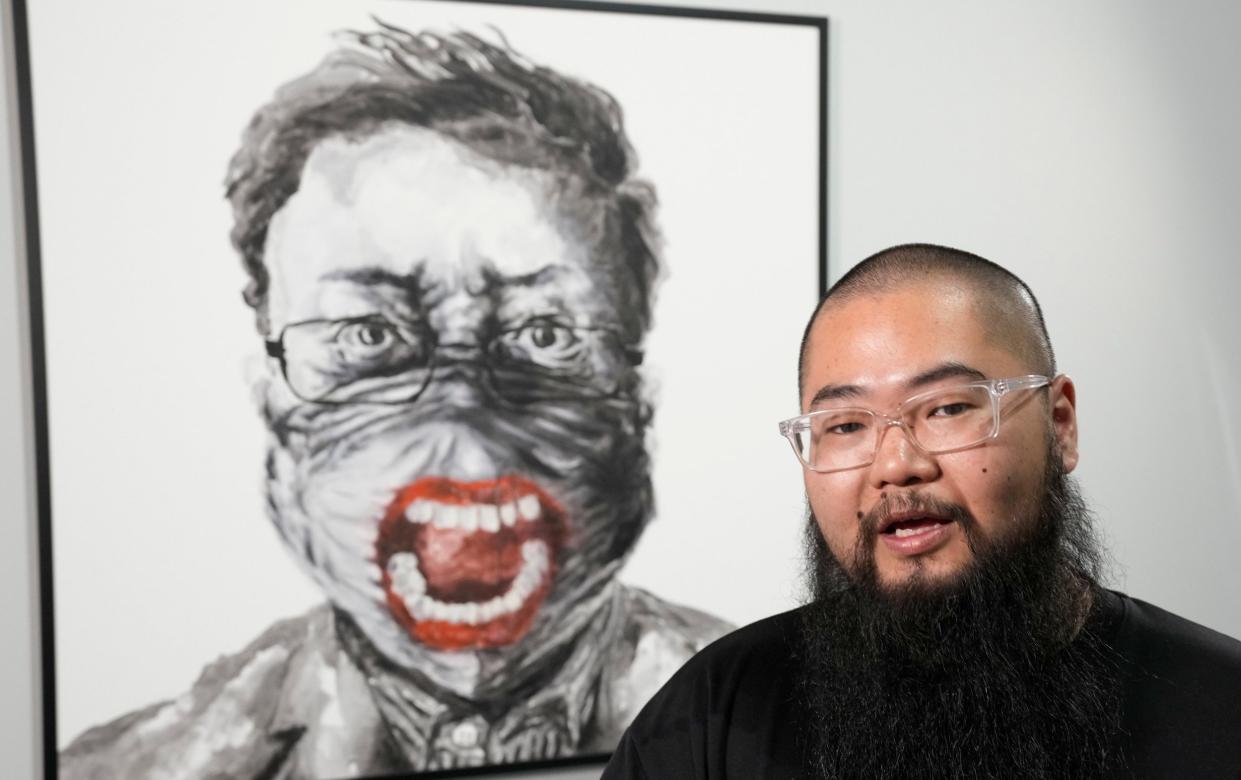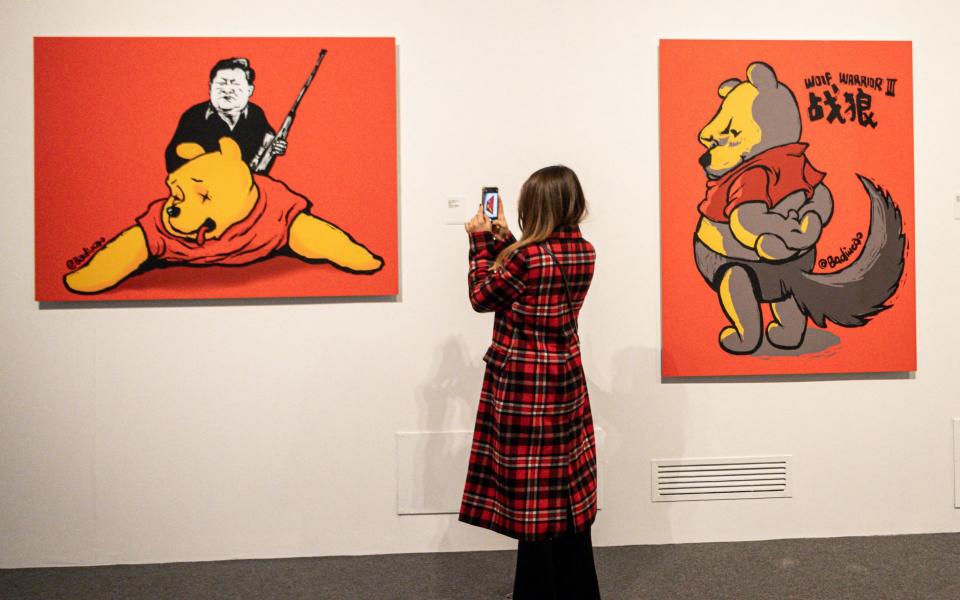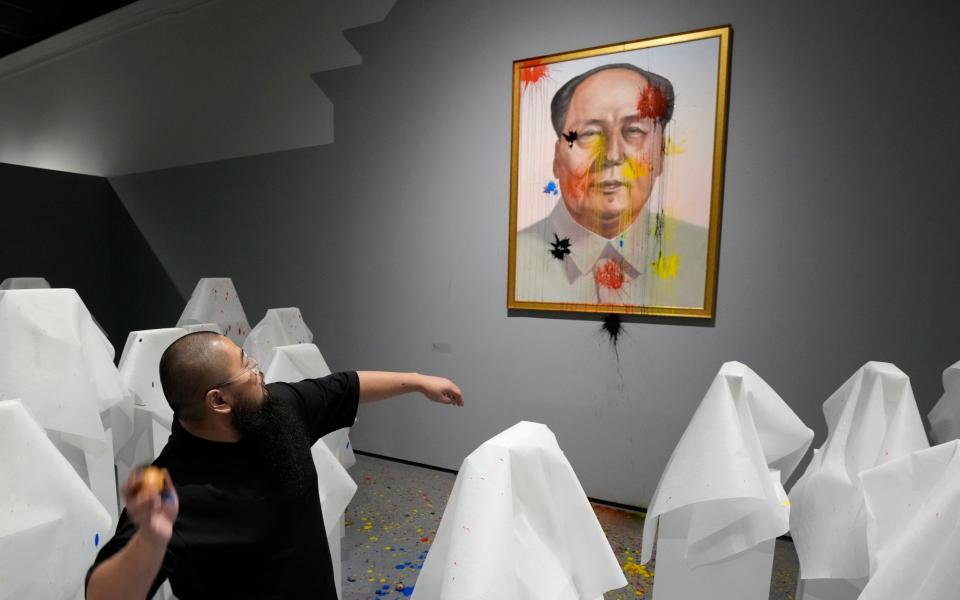‘Chinese Banksy’ says British art galleries fear being called racist

- Oops!Something went wrong.Please try again later.
A Chinese political artist who has provoked the ire of Xi Jinping has accused “Left-leaning” galleries of not exhibiting his work for fear of being labelled racist.
Badiucao, dubbed the Chinese Banksy, has gained international recognition for cartoons depicting the communist premier as Winnie the Pooh, which saw the children’s character banned by the regime.
The pseudonymous artist, whose cartoons have gone viral on social media, receives regular death threats, and those who collaborate with him are liable to suffer aggressive diplomatic pressure.
A major exhibition of his work in Warsaw, which opened last week, required round-the-clock police protection and prompted multiple visits from a senior Chinese diplomat in an effort to shut it down, as well as furious complaints to the Polish government.
On a brief visit to London this week, Badiucao said no British gallery had yet shown similar “courage”.

“A lot of people and institutions cherish their reputation more than caring about the truth,” he told The Telegraph. “They play safe.”
“The political spectrum among our [art] community is more Left-leaning,” he added.
“Because of that, they are really worried about being labelled as racist.”
A key plank of China’s so-called wolf warrior diplomacy under Mr Xi has been to conflate criticism of the Chinese Communist Party and its leaders with anti-Chinese racism.
Meanwhile its diplomats are vociferous in seeking to shut down cultural events that “hurt Chinese feelings”.
A spike in death threats ahead of the Warsaw exhibition forced Badiucao to go into “lockdown” in the Ujazdowski Castle Centre for Contemporary Art due to fear for his safety.
The exhibition features paintings of Mr Xi and Vladimir Putin eating from the flesh of dead children, as well a portrait of Mao Zedong, founder of the People’s Republic of China, with paint thrown at it.
“Before I make any agreement with a museum I tell them that this is a possibility,” he said.
“You just have to accept the whole menu.”

Now resident in Australia, the artist, in his late thirties, originally practised anonymously, giving rise to the Banksy comparison.
However, his identity was discovered by the CCP in 2018 and family were hauled into the local police station and threatened.
He has since cut off all contact with them to protect them from the official anger generated by his work.
It comes at a time of heightened awareness of China’s programme of transnational repression, which has seen an international outcry over efforts to intimidate and in some cases forcibly repatriate exiled dissidents.
“For the Chinese government, family is seen as a soft spot for every dissident,” said Badiucao.
“They want you to carry a sense of guilt – you’re the reason they’re suffering, so you must stop.”
The artist’s family has a record of persecution by the communist authorities.
His grandfather was a leading figure in Shanghai’s film-making industry in the 1940s but was later sent to a labour camp, where he vanished.
Left without her husband, Badiucao’s grandmother died of poverty.
Now a resident in Australia, he is constantly wary of his security when travelling overseas, following the kidnapping of other dissident artists and publishers.
‘Avant-garde for freedom of speech’
Only last month the Australian embassy in Poland warned him about the dangers he faced when travelling.
Fake social media accounts purporting to belong to Badiucao were also set up in the run-up to the opening, which the artist believes was the work of people working on behalf of the CCP to discredit him.
In March the communist government was accused of impersonating two foreign journalists in order to approach dissidents, including the artist, with the intention of spying on them.
However, he is determined to promote his work and its message abroad, but faces an uphill battle to persuade major galleries to take the risk of displeasing China.
“They need to do their basic job,” he said.
“I believe that art should be the avant-garde for freedom of speech, particularly those public-funded institutions.
“They should be the place where art feels safe to express those ideas.”
He added: “Intellectuals in our community have been very sensitive, and the Chinese government will insist on a racist narrative.”
Winnie the Pooh
One of the artist’s best known works depicts Mr Xi with a hunting rifle above the dead body of Winnie the Pooh, a comment on the regime’s fury at earlier depictions of the premier as the portly bear.
“When you bridge something very common and loved like Winnie the Pooh to this taboo image, like the face of a national leader, you create this catch 22 for the censorship system,” he said.
“Because if they’re censoring those, then people ask questions.”
Jessica Ní Mhainín, head of policy and campaigns at Index on Censorship, called on British galleries to step up.
“The fact that dissident artists – like Badiucao – struggle to find places to exhibit their work here is indicative of the kind of influence that China now is exerting far beyond its borders,” she said.
“Any artistic institution that values democracy and human rights should be supporting dissident artists – and one of the most important ways of doing this is by exhibiting their work.”

